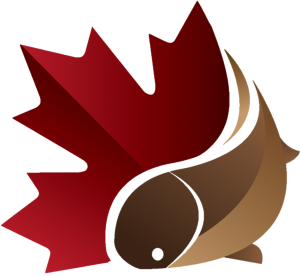
Asian Carp Canada provides in-depth knowledge on the current threat of Asian Carps introduction to the Great Lakes, including risk assessments, response and control efforts, and socio-economic impact reports.
Asian Carps
French common name: Les carpes asiatiques
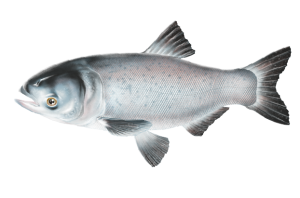
Bighead Carp
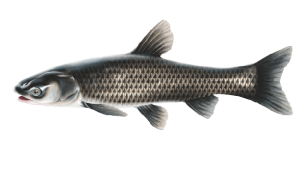
Black Carp
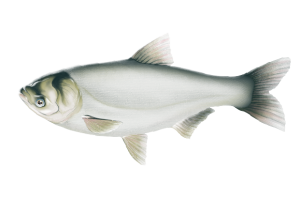
Silver Carp
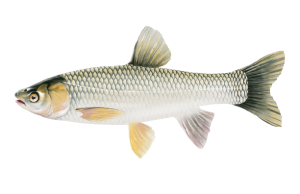
Grass Carp
“Asian carps” refers to four species of carps (Bighead, Black, Grass, and Silver) which are members of the cyprinid family and are related to several varieties of minnows. These carps are all native to the rivers, reservoirs, and lakes in China and southern Russia.
Introduction
Asian carps were introduced to the Southern U.S. in the late 1960s and 1970s for use as biological control in aquaculture facilities based on their specific diets. Flooding events allowed at least three of the four species (Bighead, Silver, and Black carps) to escape these facilities and eventually make their way into the Mississippi River Basin. The spread of Grass Carp has largely been the result of stocking for the purposes of aquatic vegetation control.
Establishment
Asian carps have established populations throughout the United States. Bighead Carp and Silver Carp populations are present through the Mississippi River Basin and the Illinois Waterway within striking distance of Lake Michigan and the Great Lakes. Black Carp are spreading towards the Illinois River and recent evidence has found natural reproduction of Grass Carp in two U.S. tributaries of Lake Erie, which is an immediate threat to Lake Erie.
There are currently no established populations of Asian carps in Canadian waters of the Great Lakes.
Impacts
These fish are of concern because of the damage they could cause to Canada’s ecological, recreational and economic environments if they established in the Great Lakes. In the absence of adequate prevention, it is predicted that Asian carp will eventually reach the Great Lakes.
- Asian carp prefer cold or moderate water temperatures, like those of the Great Lakes, and they reproduce quickly.
- Asian carps can consume up to 40% of their body weight in food each day, grow more than 25 cm during their first year, and reach a weight of 40 kg and a length of more than one meter once they have reached maturity .
- Bighead Carp and Silver Carp feed on plankton, which constitute the very base of the food chain in the aquatic environment, and spread very quickly.
- Vibrations in the water excite Silver Carp, which causes them to jump out of the water at a height of up to 3 m (9 ft). Due to the vibrations caused by boat propellers, the Silver Carp has become a danger for boaters and waterskiers; these carp have already caused serious injuries in recreational users.
- Grass Carp consume aquatic vegetation and could drastically alter important ecosystems like wetlands
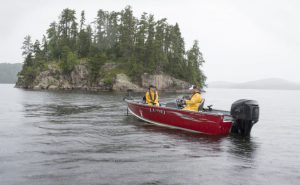
Of the four species, Grass Carp are the most immediate threat to Canadian waters due to their proximity. If you are an active boater or angler, visit the Grass Carp Identification Key and learn how to identify and report Grass Carp. Visit www.asiancarp.ca to learn more.
Fast Facts
Origin: Large rivers and lakes in eastern China and far eastern Russia
Diet: Zooplankton, detritus, and small invertebrates
Behaviour: Exhibit schooling behaviour
Life span: 16+ years
Size: Maximum 40 kg in weight, 1.5 m in length
Did you know? Bighead Carp are extremely hardy fish that can adapt to many temperate freshwater environments. Like the Silver Carp, they lack a true stomach – which requires them to feed almost continuously!
Physical Description
Bighead Carp are deep-bodied fish with a large, toothless mouth and very large head. Their eyes are located forward and low on the head, well below the axis of the body. Coloration is dark gray above and cream-coloured below with dark gray to black irregular blotches on the back and sides. Gill rakers are long, comb-like, and close-set allowing the carp to strain planktonic organisms from the water for food. They have also been known to hybridize (cross-breed) with Silver Carp and produce viable, reproductive offspring.
Preferred Habitat
Spawning can occur in many waterbodies, including moderate to large rivers and lakes with areas of slow current and depths of more than 2 m. Bighead Carp are active in cold water and begin to feed at temperatures above 2-4⁰C, preferring temperatures of 4-26⁰C. Bighead Carp are extremely hardy and can adapt to many temperate freshwater environments.
Diet
Although the name H. nobilis implies nobility, these fish are anything but; they are voracious eaters and consume a wide range of zooplankton, detritus and small invertebrates, outcompeting native species for food. Bighead Carp lack a true stomach, which requires them to feed almost continuously.
Size
Bighead Carp mature in 2-3 years, commonly weighing up to 18 kg, but can reach 40 kg (rare).
Fast Facts
Origin: Large rivers and lakes in eastern Asia from southern Russia to southern China and Vietnam.
Diet: Young feed primarily on zooplankton and later on insect larvae and detritus. Adults feed on mollusks.
Life Span:15 years
Size: Maximum 90 kg in weight, 1.8 m in length
Did you know? Scales on the back and sides of Black Carp are outlined by pigment, giving a cross-hatched effect.
Physical Description
Black Carp are elongated, laterally compressed and have a pointed head with flattened anterior portion and small toothless mouth. Their body is brown to black in color, and bluish-grey to white on the belly, with a keel from the pelvic fins to the anal fin. The fins are darker brownish-black or black with lighter hues at the base, and large overlapping scales have dark edges giving a cross-hatched appearance.
Preferred Habitat
Black Carp prefer habitats in the lower reaches of rivers and lakes, with spawning occurring in areas of high turbulence.
Diet
Young Black Carp feed primarily on zooplankton and later on insect larvae and detritus. Adult Black Carp feed primarily on mollusks, such as mussels and snails, using their pharyngeal (throat) teeth to crush the shells. They also eat freshwater shrimp, crawfish, and insects. At all life stages, Black Carp will compete for food with native species. In addition to decimating native mussel populations, this species can also negatively impact native fish, turtles, birds, raccoons, otters, and muskrats through competition for food.
Size
Black Carp reach maturity in 4 to 6 years. They can typically grow to more than 3 ft in length and weigh, on average, 33 lbs. The fish can reach up to 5 ft in length and weigh up to 150 lbs.
Fast Facts
Origin: Large rivers and lakes in eastern Asia from southern Russia to northern Vietnam.
Diet: Feed on aquatic plants but can also consume detritus, insects, small fish, earthworms, and other invertebrates.
Life Span: 5-11 years
Size: Maximum 45 kg in weight, 1.5 m in length
Did you know? Grass carp can only digest about half of the plant material they consume each day – the remaining material is expelled into the water, enriching it and promoting algal blooms.
Physical Description
The body of Grass Carp is oblong-shaped with a slightly flattened head and moderately small eyes centered on the side of the head. Grass Carp are covered with large cycloid scales and colouration varies from blackish to olive-brown with brassy or silvery-white on the sides and belly. Scales on the back and sides are outlined by pigment, giving a cross-hatched effect.
Preferred Habitat
Grass Carp prefer large, slow flowing water bodies and spawn in large rivers with moderate currents. Egg survival and larval development is best in waters at 18⁰C but adults can tolerate temperatures between 0-38⁰C.
Diet
Grass Carp feed on aquatic plants but can also consume detritus, insects, small fish, earthworms, and other invertebrates in the absence of aquatic vegetation. Grass Carp can consume up to 40% of their body weight per day and can significantly alter the composition of habitat by reducing food sources, shelter, and spawning areas for native fish. Also, because they can only digest about half of the plant material that they consume each day, the remaining material is expelled into the water, enriching it and promoting algal blooms.
Size
Grass Carp mature in about 1-10 years and reach a maximum size of over 50 kg (rare).
Fast Facts
Origin: Large rivers, canals, and lakes in eastern Asia from southern Russia and North Korea to southern China.
Diet: Phytoplankton
Life span: 15-20 years
Size: Maximum of 40 kg in weight, 1.2 m in length
Did you know? Silver carp are also known as “flying carp” because they can leap 3 m (8-9 ft) or more out of the water when startled by boat engines. They also lack a true stomach, which requires them to feed almost continuously!
Physical Description
Silver Carp are deep-bodied with a moderately large and broad head encompassing just under 1/3 of their body size. They have a toothless, upturned lower jaw and eyes are located below the axis of the body. Their body is silver with a slate gray head and dorsal surface and a white belly with a keel extending from the anal fin to the throat. Silver Carps are closely related to Bighead Carps and have been known to hybridize (cross-breed) with that species and produce viable, reproductive offspring.
Preferred Habitat
Silver Carp prefer habitats in the standing waters of rivers, canals, and lakes, tolerating water temperatures from 6-28⁰C.
Diet
Silver carp feed primarily on phytoplankton and can outcompete many native fish juveniles. They can efficiently strain suspended material from the water with specialized gill rakers that resemble sponge-like plates. Like the Bighead Carp, Silver Carp lack a true stomach which requires them to feed almost continuously.
Size
Silver Carp mature in 2-4 years and commonly weigh 9 kg but can reach a maximum size of 40 kg.
